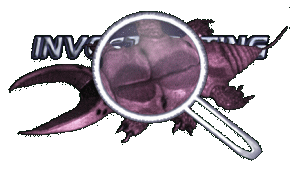
|
Biology |
Overview
This chapter deals with the
inconsistencies regarding the realization of alien life in Star Trek. It has to be
settled:
Why there are
almost only "humanoid" species in the Star Trek universe
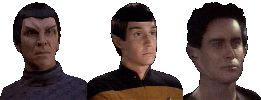 |

|
Romulans, Vulkans and Vorta:
three of the countless humanoid species |
Sheliak, Melcotians, Species 8472 and
the "Equinox aliens":
four of the few non-humanoid species |
|
Problem: Although
Star Trek is often called a diverse series which is differentiated in many ways and deals
with a large variety of cultures (remember the IDIC concept), in the original Star Trek
series, with a few exceptions (e.g. the Melcotians, Excalbians and the Gorn) almost all
alien species were shown as humans, which usually only stand out because of the color of
their clothes, skin or hair, and had shifted eye brows or pointed ears at the most. In the
new Star Trek series and movies, we still see almost always such "aliens", which
are admittedly not completely human anymore, but only differ from real humans by
odd-shaped foreheads, ears and noses. An
examination and grouping of the more than one hundred alien (intelligent) species
introduced in 35 years Star Trek shows, how predominant this problem actually is.
| Classification of the
intelligent Star Trek species |
 |
| Ia Human-like |
15% |
| Ib Completely humanoid |
47% |
| Ic Partly humanoid |
14% |
|
76% |
|
|
| II Non-humanoid |
13% |
| III Non-corporal |
11% |
|
24% |
|
Reasons: Although the problem has been explained with Star Trek's
function as a "mirror of the human society" after a fashion, i.e. the
representation of the aspects of human behaviour with the aid of human-looking aliens, it has been and still is a mere question of
budget whether aliens are shown as aliens or as cheaper, "human" aliens. Just as the transporter was originally only a resourceful
trick to avoid the unpayable costs of a weekly landing of shuttles or even the entire
starship, Gene Roddenberry pursued a similar concept with the introduction of
"humanoids" and "class M planets". His first description of Star Trek
sheds light on the origins of the Star Trek species:
| ALIEN LIFE: Normally casting roles for the many alien life-forms is
facilitated by the concept of
similar worlds. To offer continuously variations, of course wigs, skin
coloring, modifications of the nose, the hands, the ears are used, even the occasional
addition of a tail. However, the incredible differences of the universe regarding social
structure, religion, sex, politics, moral, intellect, means of transport, family life,
emotions etc. will be just as exciting as the physical differences - and often even more
exciting. |
It's somehow ironical that nowadays, in
Star Trek: Voyager shuttles crashs on alien planets are so ordinary that they are
criticized, and even Voyager lands now and then, but the problem with the humanoids
remains, although it was regarded as a means to an end by Gene Roddenberry! However, there
are counterexamples. Admittedly,
the classic Star Trek Series, which was produced with a very low budget, and also the new
Star Trek series simply don't have the money to give every alien in every episode a really
strange appearance, or rather use this money for special effects and the production
design. But vice versa, some movies with a big budget and also the newest series Star
Trek: Voyager try to show something different and have therefore created some "really
genuine" aliens - remember the infamous Federation council of Star Trek IV and VI,
denounced as "puppet cabinet", or the scary Species 8472 of Star Trek: Voyager.
Especially the last example proves that in the past, also the technical skills were
missing to show convincingly beings which weren't disguised humans and haven't two eyes,
two arms and two legs. In such cases, "non-corporal" beings like energy, cloud
or light beings were preferred. Of course, the technical and financial expenditures are
much higher for corporal, but non-humanoid species. Actually, not only the appearance had
to be alien, but accordingly also the environmental conditions, under which a potential
alien exists: atmosphere, pressure, gravity, luminosity etc. Only very rarely the authors
of Star Trek paid attention to such factors ([DS9]
Melora, [VOY] Demon). Other obstacles, like the different verbal communication, were
avoided with the aid of corresponding contrivances (the universal translator). Despite the bigger budget and the unlimited
possibilities of CGI (Computer generated images), however, such aliens are even nowadays an
exception. In the end, the true reason for the
continued use of "human aliens" not only in Star Trek, but also of most other
science fiction myths like Star Wars, Babylon 5 and Alien Nation may be the limits of
human imagination. Naturally it is difficult to depict credibly an alien, if you have
never seen one. Consequently, the depiction is orientated to the only known intelligent
life-form - the human kind. That is why the astronomers of the SETI project search for
Earth-like extra-solar planets, where life-of-the-known-kind has evolved. Although it is
extremely questionable that with regards to the immense number of variables, which led to
the genesis of life on Earth and finally to the evolution of the human beings, the process
was repeated in the same way on another planet with similar, but surely never completely
identical conditions, questions concerning the actual appearance of alien life remain
entirely speculative: How would a completely different, alien environment affect biologic
organisms? Would alien life be biologic at all, or are anorganic species like metallic
life-forms ([VOY] One Small Step) or crystal beings ([TNG] Home Soil, [TNG]
DataLore, [TNG] Silicon Avatar) possible? Are there even non-corporal species, which
consist of pure energy ([TOS] Errand of Mercy, [TNG] Lonely Among Us etc.)? All those
potential cases have been considered and depicted by Star Trek, but in the end, the saga
has maintained the picture of the "human alien", which has be coined since the
emergence of the literary genre science fiction in the 19th century.
| Potential explanation: Some
hundreds of million years ago, a species inhabited our galaxy which looked like a kind of
prototype of the human beings with a flawless, smooth skin. This species grew
thousands of years and finally they explored space, but found nothing in galaxy that
resembled to them. To protect their unique, slowly decaying species from becoming extinct,
they genetically changed the seeds of life, which were evolving |
| in the
oceans of many worlds, in a way that the seed would grow in the following millions of
years according to the life conditions, but also according to a pattern fixed in the
genetic structure. That is how the "humanoid" species of the galaxy came into
being, which have the same ancestors and are akin. Even if there are small differences,
they all have the same basic physiology. |
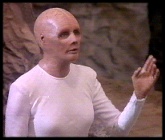
|
Additional note: This "theory of cosmic relationship" is official as of the episode [TNG] The Chase, however, it causes
some grave problems: like the immediate mutation of a living being by the manipulation of
its DNA, the postulated "determined evolution" is actually scientific nonsense.
The hypothesis premises the persuasion, the evolution could be given an aim by fixing a
particular way of development in the "genetic code" like a computer program that
needs to be interpreted. However, the biologic evolution is virtually a negation of an
aim; it is determined by natural selection of the being that adapts to its environment
best, i.e. finally by environmental factors and casual mutation. But since the officially
confirmed theory is the only reasonably plausible explanation of the "humanoid
problem", we can only accept it and ignore the raised questions.
Why the Klingons
have pronounced foreheads in the new series and the movies
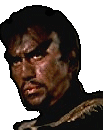
|
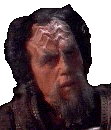
|
Kang
as "TOS Klingon" |
Kang
as "Next Generation Klingon" |
|
Problem: In the
original Star Trek series, the Klingons are bearded, dark-skinned, but completely human
beings, whereas since Star Trek: The Motion Picture and all following movies as well as
the new Star Trek series, they are shown with a characteristic bumpy forehead. Moreover,
Klingons that were already shown in TOS suddenly appeared as "Next Generation
Klingons" in Star Trek: Deep Space Nine. Finally in [DS9] Trials and Tribble-ations
both types of Klingons were shown simultaneously on screen, when Worf joins a bar brawl
with the Klingons on Deep Space K-7. Therefore, the two types can't be explained by a
different reproduction of the Klingon appearance in the old and the new series.
Reasons: In
fact, the Klingons were planned as a "non-human" species from the very
beginning, but the budget of the original Star Trek series was far too small to allow an
extensive alien make-up for the Klingons. Already the appearance of Vulcans and Romulans
required notable expenditures. Consequently, for most aliens, more economical effects,
like a different color of the hair or skin, were used, or simply human-looking beings were
sold as "aliens". With Star Trek: The Motion Picture, a movie with a
considerable budget and therefore amazing production values and special effects, the
Klingons finally got a realistic, "alien" appearance: beside the dark-brownish
color of the skin, which isn't the natural color of some actors (like the white J.G.
Hertzler who plays Martok), a pronounced forehead and a slightly wrinkled nose were added
to make them wilder and scarier. Of course, for all following productions, the same
Klingon appearance was used, and it was adapted for televion as well. However, in the last
years the problem with the two types of Klingons has even been reinforced, since
Klingons of the original series (e.g. Kahless, Kang, Koloth and Kor) were suddently shown
with the characteristic, bumpy forehead in the new Star Trek series - in the 24th century ([DS9] Blood Oath, [DS9] The Sword of
Kahless, [DS9] Once More Unto the Breach) as well as the late 23rd century ([VOY]
Flashback). There isn't any official explanation up to now, although there were was a
suitable occasion in [DS9] Trials and Tribble-ations, which wasn't used in favor of a
cheesy remark ("We don't talk about it.")
Potential explanation: Since
first contact with the Klingons in the year 2218, this warlike species was an adversary of
the Federation; there wasn't a peace treaty, let alone a cultural exchange in the
following seventy years, therefore the Klingons, their nature and their culture mostly
remained unknown during this time span, which also includes the historical five year
mission of the USS Enterprise under the command of Captain Kirk. Thus, it is not
surprising that at his time, nobody knew that the Klingons kept their true identity and
their real appearance a secret, in order to confuse their adversaries and to attain a
tactical advantage. Like they concealed their rich culture based on the concept of honor
and behaved as nasty criminals instead, they also concealed how they really look like: the
appearance of those Klingons who were stationed at the border to the Federation or who
were in contact with human beings was adapted to the human appearance. When in 2278, the
year of the V'Ger incident, peace negotations between Federation and Klingon Empire were
initiated, the Klingons revealed their true appearance because the humans were no longer
their adversaries.
Why the
Romulans outwardly differ from the Vulcans in the 24th century
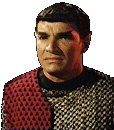
|
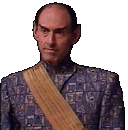
|
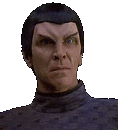
|
The
Romulan commander from TOS looks like a Vulcan |
Ambassdor
Nanglus of Star Trek VI looks identical as well |
Telek R'Mor as a "Next
Generation Romulan" |
|
Problem: In the episode [TOS] Balance of Terror, a new, dangerous
enemy of the Federation was introduced, which - to the horror of Mr. Spock - looks alike
the Vulcans: the Romulans, that were laready involved in a war with Earth in the years
2155-60, supposedly shortly after the first contact. The episode clarifies that the reason
for the identical physiology most probably is a common origin of both peoples, i.e.
Vulcans and Romulans seem to belong biologocially to the same species, which only differ
in their cultures and way of lifes. According to official Star Trek history, the Vulcans
followed Suraks way of logic 2000 years ago, while a group of opportunists refused to
abandon hteir emotionality in favor of the new teachings of reason. They left Vulcan and
spreaded across the Galaxy until they finally reached a new home: Romulus and Remus. This
chronology perfectly matches with the identicial appearance of Romulans and Vulcans, which
(in contrast to the Klingon development) was maintained during the "classic"
feature films I to VI. For the new series Star Trek: The Next Generation, Star Trek: Deep
Space Nine and Star Trek: Voyager, however, the Romulans got a slightly different
appearance. Consequently, in [TNG] The Neutrale Zone for the first time a Romulan appeared
who physiologically differed from the Vulcans. Although these differences are minimal and
can be almost missed, they are biologically impossible after a only 2000 years lasting,
isolated development. Although there isn't an overlapping of both types of Romulans like
concerning the Klingons, i.e. one and the same individual was shown as both types, an
equally simple explanation isn't possible this time, since in [TNG] Reunification, an
episode which shows "Next Generation Romulans" without exception, Spock is
accepted as a Romulan apparently without difficulty.
Reasons: When the original Star Trek Series was produced back in the
1960s, it has been always a question of budget that aliens were often shown as human or
very human-like life-forms, however, in this case it was dramatic intention to give the
Romulans and the Vulcans a common appearance. Unfortunately, during the development of
"Star Trek: The Next Generation" in 1987 the producers decided to give the
Romulans - like the Klingons - an "enhanced" make-up in the form of a darker,
mostly beige-greenish skin color and, above all, a pronounced, bulging forehead, without
paying attention to the impossibility of the corresponding genetic alteration. Like the
Klingons, the official sources suggest mere makeup-caused differences between both Star
Trek generations, not "real" physiogical deviations, an impossibility in view of
the given facts.
Potential explanation:
After the group of Vulcan opportunists left Vulcan
during Suracs revolution of logic and reason 2000 years ago, they had to walk a long way
in search of a new home. Decades, probably even centuries, they crossed interstellar space
with their primitive, not warp-propelled ships, and settled or conquered numerous
planets. In the Kaleb sector, the Taugus sector and adjoining areas of space near the
later Romulan Neutral Zone and the Klingon Empire, still today the remains of these
ancient Romulan colonies can be found, e.g. on Yadalla Prime, Calder II, Dessica II,
Draken IV. While these planets were formerly uninhabited, the Romulans discovered in the
same sectors planets like Barradas III, which were outposts of another space-travelling
cilivisation - the Debrune. Either in peaceful co-existance, but most probably by
subjugation of the other culture, the Romulans settled there as well, leading to a
cross-breeding and mixture of both species. A few Debrune hereditary factors were
integrated into the dominant Romulan DNA. The Debrune-Romulan hybrides had a slightly
different skin color and a charasteristic forehead, separating them from the "Vulcan
Romulans". The Romulans finally left the planets in those sectors and moved to
Romulus and Remus, two planets which became there definite home, located about 50 ly away
from Vulcan. Although the Debrune-Romulans were in the majority, two Romulan races kept on
existing. Consequently, a Vulcan does not stand out on Romulus, since he is regarded as a
"Vulcan Romulan". |
|
Additional note: Although this theory, which was suggested by Bernd Schneider for the first time, of course is fairly
daring and highly speculative, it seems probable with regards to the clues given in Star
Trek: The Next Generation and, above all, the further development of Romulan history in
[TNG] Gambit, which the hypothesis is based on to a high degree. In the end, regarding the
Romulans always a similiar, but not an identical physiology was cited,
therefore the integration of alien hereditary factors into the Romulan genotype cannot be
ruled out. The most conclusive proof for this assumption was given in [TNG] The Enemy,
since according to this episode, Vulcans and Romulans differ enough to make a ribosome
transfusion between both species impossible.
Why the
Ktarians look different in Star Trek: Voyager
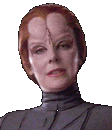
|
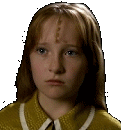
|
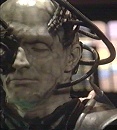
|
Etana
Jol,
"TNG" Ktarian |
Naomi
Wildman,
"VOY" Ktarian |
Tactical
drone,
Ktarian at all? |
|
Problem: The episode [TNG] The Game is the first and sole episode of Star Trek: The
Next Generation, in which the Ktarians play an important role and were shown on screen.
Etana Jol, a Ktarian woman, used a mobile, addictive and thought-controlling VR device
called "the Game", to keep the crew of the Enterprise-D under control and, as
the final goal, to infiltrate and take over the entire Federation. The plan was foiled and
the Ktarians, of which apparently all or at least many were involved in the invasion
called the "Expansion", played never a role again.
In Star Trek: Voyager, we already learn in the episodes
[VOY] Elogium and [VOY] Dreadnought that Ensign Wildman expects a baby from her Ktarian
husband who stayed behind on Deep Space Nine; a baby that consequently will be a
human/Ktarian hybrid. When Naomi Wildman is finally born in [VOY] Deadlock, however, she
looks considerably different than Etana Jol in TNG. Moreover, in a large number of Voyager
episodes before and after Naomis birth, the Ktarians have been established as a familiar
species, which is popular in the entire Alpha Quadrant because of their culture and which
is in very friendly terms with the Federation or even a member. These facts contrast
sharply with the image of a hostile, insidious species that was established in TNG, how
the following summary proves:
| Difference
|
Proves |
| Appearance |
The TNG Ktarians have a
quite alien physiology ([TNG] The Game): Etana Jol has a reddish skin color, feline eyes
and two characteristic bulges on her forehead, with a fissure between them. Naomi Wildman,
on the other hand, has a almost entirely human appearance, apart from three small horns on
her forehead. According to the doctor, these "cranial ridges" are running from
the middle of the forehead over to the back of the head; furthermore, the Ktarians would
have scales on some parts of their body and protruding incisors up to three or four weeks
after the birth ([VOY] Deadlock). |
| Names |
The TNG Ktarian has a
melodious name consisting of first name and surname: "Etana Jol" ([TNG] The
Game). Ensign Wildman's Ktarian husband ([VOY] Dreadnought, [VOY] Fury), on the other
hand, has a virtually unpronouncable, one-piece name: "Greskrendtregk" ([VOY]
Dreadnought) |
| Home planet |
The home planet of the
Ktarians is, according to Chakotay, Ktaria VII ([VOY] Emanations), speaking of
"Ktarians" in general. Thus, it is unclear whether he refers to the hostile
species from TNG or the Federation member introduced in later Voyager episodes. In the
sixth season, however, "Katurus" is named as home planet with regards to Naomi
Wildman and therefore definitely the VOY Ktarians, who belong to the Federation ("It's
Katurus" - "Your father's planet", [VOY] Child's Play). Consequently,
it can be supposed that the first planet is the home planet of the TNG Ktarians and the
latter one the homeworld of the VOY Ktarians. |
| Political affiliation and
relations to the Federation |
The TNG Ktarians are described as
a neutral, non-allied, independent species, which apparently hasn't had much to do with
the Federation before. However, in 2368, they tried to take over the Federation with an
insidious invasion plan ([TNG] The Game). In view of the size and power of the Federaiton,
it is improbable that only Etana Jol or a small faction is responsible for this
"Expansion".
The VOY Ktarians, however, are a member of the Federation ("The Ktarians
were officially with the Federation but they sympathized with the Maquis", [VOY]
The Voyager Conspiracy). Many of them even live on Earth ("And hundreds of
different humanoid species live there: Vulcans, Bolians, Ktarians...", [VOY]
Hope and Fear). |
| Degree of fame |
The TNG Ktarians play only
a role in one episode ([TNG] The Game) and are neither shown nor referred to in any other
episode. Thus, they seem to be very unimportant and/or unknown, i.e. the Federation seems
to know not very much about their culture. Only their burial rites were mentioned by
Chakotay, who visited their home planet once (([VOY] Emanations), and a Ktarian sweet dish
by Deanna Troi ("Ktarian chocolate puff", [TNG] Liasons) , assuming that both
meant the TNG Ktarians (rather improbable concerning the latter quote). The VOY Ktarians,
on the other hand, are mentioned in countless references; there culture seems to be
well-known as well as popular. This isn't surprising, if they are a Federation member and
many of them live on Earth. The quotes cover the seemingly outstanding Ktarian cuisine ("Ktarian
Merlot. 2282.", [VOY] Scientific Method; "One Ktarian Pudding",
[VOY] Someone to watch over me, "Ktarian eggs, a favorite of Antonia",
ST:G), the Ktarian homeworld, apparently a preferred resort ("Ktarian Music
Festival", [VOY] Non Sequitur; "Ktarian glaciers, renowned for
excellent skiing", [VOY] Macrocosm; "We'll run the Ktarian moonrise
simulation. It's beautiful.", [VOY] Revulsion) as well as the Ktarian physiology
("They have cranial ridges running from the middle of their forehead over to the
back of their head, and scales on some parts of their body", [VOY] Deadlock; "Female
... half Ktarian, as a matter of fact; which should nearly double the infant's gestation
period", [VOY] Fury) |
In view of the differences regarding
the degree of fame and the political affiliation it is not only improbable, but completely
impossible that the VOY Ktarians and TNG Ktarians are the same species, an assumption that
is underpinned by the entirely different appearance and the innumerable references in Star
Trek: Voyager. However, this natural assumption was never proven on screen; instead, both
species are called "Ktarians". The problem is increased in [VOY] Dark Frontier,
since obviously a third type of Ktarians is introduced there: the tactical drone
classified as "Ktarian... species 6961" neither resembles the VOY Ktarians nor
the TNG Ktarians. Apart from an oddly shaped chin, he is completely human. In this case,
we can therefore only suppose that it is a mistake and have to ignore the scene, which
only lasts a view seconds anyway.
Reasons: It is likely that (not for the first time) the bad research
of the authors is responsible for the occurrence of this problem. In [TNG] The Game, the
Ktarians were introduced as typical "malicious aliens of the week". They never
appeared again on screen and were mentioned only twice some years later in a TNG episode
([TNG] Liaisons) and a TNG feature film (Star Trek: Generations). When in the first season
of Star Trek: Voyager ([VOY] Elogium) the authors decided to make Ensign Wildman's husband
a Ktarian and consequently her unborn child a half-Ktarian, they had probably forgotten
the reason for their appearance in TNG. However, this fact alone cannot regarded as a
problem, even though a relationship with a such hostile species and a residence permit for
Greskrendtregk on DS9 seems to be odd. Either the authors had discovered the mistake in
the nick of time or it was mere ignorance, when finally in [VOY] Deadlock Naomi Wildman
got an entirely different appearance. Now, that the "VOY Ktarians" had been
established, they became a typical "reference species", i.e. a culture, which is
often used in dialogues regarding events, food etc. At this point of the development, a
one-species-explanation was still likely, however, it become completely impossible after
[VOY] Hope and Fear, [VOY] The Voyager Conspiracy and [VOY] Child's Play. In the
end, it remains unknown if the "separation" of the Ktarians into two species in
these episodes was intention or unfortunate coincidence.
Potential explanation: Just as there are the Terellians, Tyrellians and Tarellians,
there are two species in the Galaxy which considerably differ in physiology, history and
political significance, but have a homophonic name: the Ktarians and the
Katurians.
The latter ones are a Federation member, and many people of this species live on
Federation planets. They are well-known in the entire Alpha Quadrant because of their rich
culture, their home planet Katurus is a popular resort and their cuisine is appreciated beyond
Katurian borders.
The different looking Ktarians, on the other hand, are a fairly unknown, politically
neutral species which lives secludedly outside the Federation. In the past, contact was
only rarely established. Few Federation citizens have visited their home planet Ktaria VII during an
expedition, and consequently only little is known about their culture and way of living.
Since the Ktarians have tried to conquer the Federation with their "Expansion"
in 2369, they are regarded as outlaws; any contact with this species has been aborted.
|